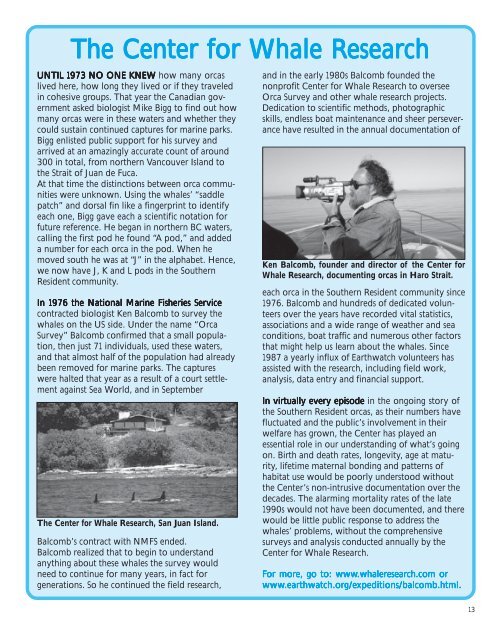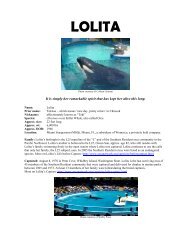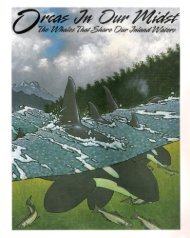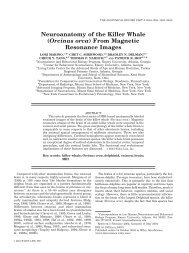You also want an ePaper? Increase the reach of your titles
YUMPU automatically turns print PDFs into web optimized ePapers that Google loves.
The Center for Whale ResearchUNTIL 1973 NO ONE KNEW how many orcaslived here, how long they lived or if they traveledin cohesive groups. That year the Canadian governmentasked biologist Mike Bigg to find out howmany orcas were in these waters and whether theycould sustain continued captures for marine parks.Bigg enlisted public support for his survey andarrived at an amazingly accurate count of around300 in total, from northern Vancouver Island tothe Strait of Juan de Fuca.At that time the distinctions between orca communitieswere unknown. Using the whales’ “saddlepatch” and dorsal fin like a fingerprint to identifyeach one, Bigg gave each a scientific notation forfuture reference. He began in northern BC waters,calling the first pod he found “A pod,” and addeda number for each orca in the pod. When hemoved south he was at “J” in the alphabet. Hence,we now have J, K and L pods in the SouthernResident community.<strong>In</strong> 1976 the National Marine Fisheries Servicecontracted biologist Ken Balcomb to survey thewhales on the US side. Under the name “<strong>Orca</strong>Survey” Balcomb confirmed that a small population,then just 71 individuals, used these waters,and that almost half of the population had alreadybeen removed for marine parks. The captureswere halted that year as a result of a court settlementagainst Sea World, and in SeptemberThe Center for Whale Research, San Juan Island.Balcomb’s contract with NMFS ended.Balcomb realized that to begin to understandanything about these whales the survey wouldneed to continue for many years, in fact forgenerations. So he continued the field research,and in the early 1980s Balcomb founded thenonprofit Center for Whale Research to oversee<strong>Orca</strong> Survey and other whale research projects.Dedication to scientific methods, photographicskills, endless boat maintenance and sheer perseverancehave resulted in the annual documentation ofKen Balcomb, founder and director of the Center forWhale Research, documenting orcas in Haro Strait.each orca in the Southern Resident community since1976. Balcomb and hundreds of dedicated volunteersover the years have recorded vital statistics,associations and a wide range of weather and seaconditions, boat traffic and numerous other factorsthat might help us learn about the whales. Since1987 a yearly influx of Earthwatch volunteers hasassisted with the research, including field work,analysis, data entry and financial support.<strong>In</strong> virtually every episode in the ongoing story ofthe Southern Resident orcas, as their numbers havefluctuated and the public’s involvement in theirwelfare has grown, the Center has played anessential role in our understanding of what’s goingon. Birth and death rates, longevity, age at maturity,lifetime maternal bonding and patterns ofhabitat use would be poorly understood withoutthe Center’s non-intrusive documentation over thedecades. The alarming mortality rates of the late1990s would not have been documented, and therewould be little public response to address thewhales’ problems, without the comprehensivesurveys and analysis conducted annually by theCenter for Whale Research.For more, go to: www.whaleresearch.com orwww.earthwatch.org/e.earthwatch.org/expeditions/balcomb.html.13







